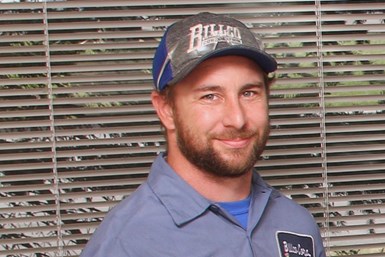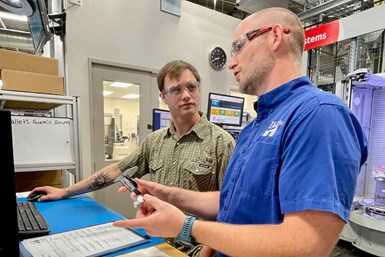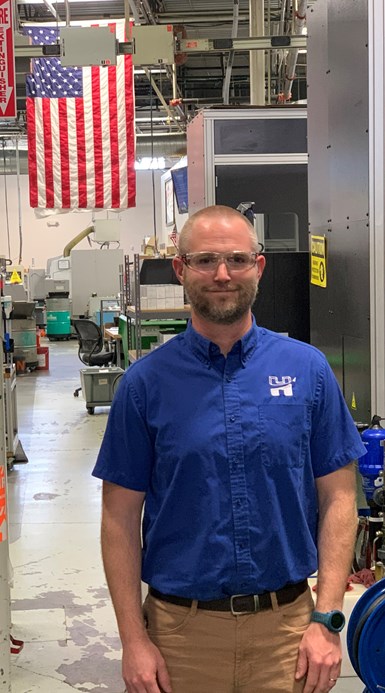Filling the skills gap, retaining employees, implementing automation – manufacturing can define these realities on shop floors across the country as obstacles or, more positively, challenges that can boost a workplace. After speaking to the four 2022 Production Machining Emerging Leaders, I sensed that although these young leaders clearly understand the issues at hand, they are accepting of them and eager to move forward with a plan to overcome these common pains felt throughout the industry.
These bright leaders making a difference in the precision machining industry are often found demonstrating their talents and passion for their careers by hustling on the shop floor, working right next to their co-workers who they might be managing. Therefore, they are familiar with not only the dealings in the company office but also the concerns of the operators sweating at a machine. Most important, they are willing to share their expertise and experiences about how to cope with daily challenges gracefully.
Hirsh Precision Products offers a robust onboarding process for new hires that usually involves one to two weeks of training in the quality assurance department. Photo Credit: Hirsh Precision Products Inc.
While the labor shortage continues, our Emerging Leaders tell me their shops are now focusing more on employee retention and engagement than ever before. They explain that in-house training has been a path to keeping more employees content. When they do hire from outside the building, they are looking for quality workers as opposed to quantity. All the leaders voice that they hire based on character rather than specific skill sets.
As for equipment, finding ways to be more productive with less skilled workers points to automating processes when possible.
A Mindset Shift
Although it is easy to follow the “we’ve always done it that way” patterns in business, sometimes a recurring issue can act as a wake-up call to shake up a normal routine. Currently, that issue is the inability to hire people who have the skills necessary to operate machines. Therefore, our Emerging Leaders

Ryan Cochran, vice president of operations, Billco Corp. Beginning his career as a machinist has helped Cochran work his way up in his family’s business. He says now he does a lot of machine maintenance and repair, and wherever there is a problem is where he can be found. “My job is to keep the machines running and keep the whole operation going around,” he explains. His leadership philosophy is to be on the same level as all employees. “We’re all in this together.” Photo Credit: Billco Corp.
are choosing to give people of good character, as opposed to only experienced machinists, the opportunity to shine on the shop floor. That being said, they are not all together abandoning the attempt to hire experienced operators with the aid of local schools and other traditional hiring methods. They are simply broadening the talent pool by being open minded to less experienced candidates.
For example, Emerging Leader Ryan Cochran, V.P. of operations at Billco Corp. in Addison, Illinois, says his shop, which has been manufacturing pipe fittings since 1973, has been successful hiring people with no machining background and then training them in-house for specific positions, which he calls “from the ground up training.” Usually, he can tell by judging their character in the interview if candidates will be a good fit for the shop culture and the type of work that is necessary.
“If I think they are good fit, I will spend however long it takes with them to bring them up to speed,” Cochran explains. “This has been working well because they don’t have bad habits learned at another shop. I show them how to do the job the way we want it done.”
Emerging Leader Ben Nikkel finds that when his company, Hirsh Precision Products Inc. in Boulder, Colorado, hires for personality and culture fit over technical ability, those people are usually the ones that stay at the company longer and are often the most successful. “They don’t come in expecting anything,” explains the production scheduling manager. “They are humble and eager to learn, and everything is engaging to them.”
Ben Nikkel, production scheduling manager, Hirsh Precision Products Inc. Nikkel’s main role is to manage the production schedule for the entire shop, from purchasing material to releasing job orders on the floor. He ensures that production is flowing smoothly and properly while meeting customer deadlines. Nikkel says his leadership philosophy is to trust his employees without micromanaging as well as leading by example. “I tell myself every morning to step back, let them do it their way. It’s OK to fail because that’s how we learn.” Photo Credit: Hirsh Precision Products Inc.
Programs for New Hires
Once these new, inexperienced workers are in the door and ready to learn, what should on-the-job training look like? One approach is for management to act as the trainers. Cochran believes this alleviates the pressure for one of his machinists who normally might be assigned the responsibility of training a new hire. Therefore, he potentially saved those existing employees from looking for employment elsewhere.
Although this training method can be effective if management has the skill set to do so. Otherwise, appointing on-the-job training to experienced employees who enjoy teaching and sharing their wisdom with others can be equally effective.
For example, Hirsh Precision Products, a machine shop that manufactures parts for the aerospace, medical device, scientific and industrial industries, offers a robust onboarding process that usually involves one to two weeks of training in the quality assurance department, according to Nikkel. Trainers who have been with the company for a long time give new employees training on precision measuring instruments such as micrometers and teach them how to read and use these instruments.
“We don’t just assume even someone coming from trade school knows how to use these gages correctly because they sometimes don’t,” he says. From there, the training enforces the meaning of quality and the responsibility of a machinist regarding quality.
Once the quality training is complete, Hirsh trainees are assigned a work cell which has a lead cell trainer who takes trainees to the next stage. The trainee will start operating, getting acquainted with the parts being machined and the pace of work in that cell, Nikkel says. After they are comfortable with that process, they will begin working on setups. This progression lasts anywhere from six weeks to one year.
Training as a Retention Strategy
Although there has been much emphasis on hiring, retaining existing employees can be even more critical. Workers who are already trained for their current positions are valuable, but it is no longer safe to assume they
Joel Antipuna Jr., manufacturing manager, Rosenberger North America Implementing shadow foam at some of the shop’s machine tools is one method Antipuna has used to improve processes on the shop floor to save operators time. The shadow foam has been especially successful for the Swiss lead at one of the company’s new Star CNC SW-20 Swiss-type lathes. Antipuna’s leadership philosophy is to be authentic and respectful, which includes giving constructive criticism and establishing and maintaining synergy within a team. Photo Credit: Rosenberger North America
are content and engaged with the job they are assigned to do. Therefore, management needs to be proactive about training employees to expand their capabilities.
Rosenberger North America in Pennsauken, New Jersey, functions with this mentality. This company — which produces machined parts, gaskets, fixtures and tooling — focuses on improving the technical skill set of the entire team and advancing each employee’s skill level, according to Emerging Leader Joel Antipuna Jr., manufacturing manager. “All the employees have the opportunity to advance and earn promotions,” he says. “We need people who are hardworking and motivated to continue learning.”
Employee engagement is also a big emphasis at Hirsh Precision Products. Nikkel credits engagement as the number one reason employees stay at a company. He says as soon as workers are no longer interested in the company mission, they are going to find something else more exciting to do.
For that reason, Hirsh offers its workers plenty of opportunities for hands-on training. “If you’re working with the mills and you want to try lathes, all you have to do is ask,” Nikkel explains. “It’s not going to happen tomorrow, but we will make it happen and be sure you are challenged and engaged.”
To keep its employees at all levels happy and help them understand the entire business, Norman Noble, a contract manufacturer of medical devices located in Highland Heights, Ohio, is in the beginning stages of building a training program for its entire staff. Emerging Leader Josh Hoppert, 5-axis programmer/milling lead, says the shop already trains all its employees, new and current, up to the level at which they feel completely capable in their positions. However, the company is implementing Training Within Industry, a method of hands-on training, learning and coaching for supervisors, team leaders and workers that is done both in a class setting and on the shop floor.
Josh Hoppert, 5-axis CNC programmer/milling lead, Norman Noble Inc. Helping develop and machine medical parts has been gratifying for Hoppert, who has been working on a delivery device for a heart implant since the beginning of the project. “I’ve carried that basically from prototype to production,” he says. “I’m proud of being in the medical field because, at the end of the day, you know you’re helping people.” His leadership philosophy is to respect his colleagues and lead by example. Photo Credit: Norman Noble Inc.
“We are using this for our owners all the way down to our operators,” Hoppert explains. “The owners and upper management have already started going through the basic courses. And they are starting to work with some of the leads on the shop floor. It was neat being able to see this portion of the company doing that and making up for the skills gap in a unique way.”
Hirsh Precision Products also offers an online training academy which is made up of a series of classes developed by shop staff who have expertise in a certain area, such as programming basics and tool geometry basics. Nikkel says any employee can sign up to take the courses at any time.
Other Ideas for Retention
While workers have many opportunities for employment in the current market, Hoppert makes the point that it is increasingly critical that proper company leadership is in place. Without leadership that respects all employees, workers will more readily walk out the door. “It’s important to have leadership to work with your employees, to communicate effective with them to understand and help them throughout the day, and not just force them to run a machine,” he explains.
“Making sure we always have the newest equipment and a very clean shop environment provides a nice place to work,” Antipuna says.
Again, keeping workers engaged is key. Taking employees to trade shows and industry conferences is one approach that Cochran says Billco implements. He also recommends paying them well and awarding bonuses periodically.
Antipuna knows Rosenberger employees value rest and relaxation when possible, so ensuring enough vacation time and 12 paid holidays off is important to the company to keep its workers happy. Offering a generous benefits package that includes 401K and good health insurance is also crucial, he says.
Continuous capital equipment investment might not be a common consideration for employee retention, but Antipuna notes that by integrating the latest technologies onto the shop floor does not only benefit customers. “Making sure we always have the newest equipment and a very clean shop environment provides a nice place to work,” he says. “And employees are not working with faulty equipment or machines that are always down. We want to be sure they have the tools necessary to do their jobs as best as possible.”
Automation Appeal
Automation is another way to address the skilled labor shortage. Therefore, most of our Emerging Leaders, besides the bar feeders they already implemented, are helping integrate robots and other automation on their shop floors to create error-free processes that can run unattended.
For Cochran, automation has come in handy for loading and unloading one of Billco’s high-production milling centers with an indexing table. There are two Paws Workholding stations attached to it on both sides of the table, he explains. So it is clamping eight individual pieces and then machining those parts while the operator unloads and loads another eight pieces on the other
“Everything is set up to plug in a robot, which will eventually be doing the loading and unloading instead of having an operator in there,” Cochran explains.
side of the table. Then the table indexes, goes right back into the cut and machining those eight pieces while the operator is unloading and loading again. This process has eliminated downtime for the company. Because of its positive experience with automation which eliminates loading and unloading time, the shop is going in that direction for all its machines. The shop already has two machines with two robots each for loading and unloading.
Cochran adds that he has this milling center completely robot ready. “Everything is set up to plug in a robot, which will eventually be doing the loading and unloading instead of having an operator in there,” he explains. “It’s ready to go to be fully automated. We’re just waiting for a little more work for it to justify the expense of a robot.”
Norman Noble is also automating processes as much as possible. Hoppert gives an example of the company’s cleaning system. He explains that instead of an operator waiting for parts to be cleaned in a tank and then moving them to another tank for rinsing, as it once did, its new system is fully automated. “We load up the staging area with racks and parts, and a robot arm moves it from time to time,” he says. “There are no errors, and timing and temperature settings are correct.”
The shop is also using robotic arms for loading parts on other machines, Hoppert adds. However, he says some parts they manufacture are so small that they still require skilled labor to machine, making automation for those workpieces challenging.
Although automation has many advantages, these young leaders realize that there are certain applications that are better off as attended work by a skilled machinist. For instance, Nikkel points out that although Hirsh is adding a lot of automation throughout the shop, it is still hiring workers as well, keeping quality workers, not the quantity of workers, top of mind. He says setting up new part orders is where a particular skill set is required. Therefore, when a job is set up on a machine by one of Hirsh’s skilled workers, the hope is to leave it set up for the next part order from that customer, so repeat setup is not necessary.
Related Content
Job Candidate Questions and What They Tell Us
Individuals who ask thoughtful, original questions in the interview set themselves apart.
Read MoreSuccession Planning: Three 15-Minute Activities to Start Preparing for Tomorrow
Succession planning is planning for the future success of your business.
Read MoreRecognizing Signs of a Degrading Workplace Culture
Is your machine shop missing key “culture elements?” Here are ways to identify if your organization is heading in the right or wrong direction in terms of establishing a healthy company culture.
Read MoreCNC Machine Shop Employment Positions to Consider Beyond Machine Operators
Many machine shops have open machine operator positions to fill. But does it make sense for shops to also seek automation engineers, IT managers and assembly personnel?
Read MoreRead Next
Young Leaders Define Their Business Strategies
Production Machining 2021 Emerging Leaders share their approaches for developing skilled labor and ensuring that continuous improvement is top of mind to keep their companies competitive.
Read MoreMeet Production Machining’s 2020 Emerging Leaders
This year’s 10 Emerging Leaders have many character traits in common that shine well beyond the buildings in which they are employed. Their leadership skills and willingness to help others grow within their skill sets has proven that the precision machining industry’s future is bright in the hands of these talented individuals.
Read MoreEmerging Leaders Nominations Now Open
Here’s your chance to highlight a young person in your manufacturing business who is on the path to be a future leader moving your company forward.
Read More
















.jpg;maxWidth=300;quality=90)










